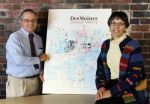(Press-News.org) New Rochelle, NY, October 6, 2010 –Climbers of high peaks such as Mount Kilimanjaro are at high risk for Acute Mountain Sickness (AMS). Trekkers should not ignore AMS warning signs, which can progress to more serious medical outcomes. Mountain climbers can best minimize their risk for altitude sickness by becoming acclimatized to increased altitudes before an ascent, according to a study in the current issue of High Altitude Medicine & Biology, a peer-reviewed journal published by Mary Ann Liebert, Inc. (www.liebertpub.com). The article is available free online at www.liebertpub.com/ham
The study, entitled "Incidence and predictors of acute mountain sickness among trekkers on Mount Kilimanjaro," evaluated the incidence of AMS among trekkers of this popular climbing destination. Stewart Jackson, J. Kenneth Baillie, and colleagues from University of Edinburgh (Scotland) and Muhimbili University College of Health Science (Tanzania), compared the effects of three increasingly difficult and rapid ascent routes, the option of a single rest day during the climb, and use by a sub-group of climbers of prophylactic acetazolamide.
The authors reported a similar rate of AMS among climbers with or without prophylactic drug use. Furthermore, a mid-climb rest day did not affect the incidence of AMS. Only prior acclimatization to increased altitude offered a significant protective effect against AMS.
"This important article emphasizes the dangers of rapid ascent rates on a mountain that attracts thousands of visitors every year. Hopefully it will help to reduce the high frequency of high altitude diseases," says John B. West, MD, PhD, Editor-in-Chief of High Altitude Medicine & Biology and Professor of Medicine at the University of California, San Diego School of Medicine.
INFORMATION:
High Altitude Medicine & Biology, the Official Journal of the International Society for Mountain Medicine (www.ismmed.org), is an authoritative, peer-reviewed journal published quarterly online and is the only journal dedicated exclusively to the latest advances in high altitude life sciences. The Journal presents findings on the effects of chronic hypoxia on lung and heart disease, pulmonary and cerebral edema, hypertension, dehydration, infertility, appetite and weight loss, and other diseases. Complete tables of content and the full text for this issue may be viewed online at www.liebertpub.com/ham
Mary Ann Liebert, Inc. is a privately held, fully integrated media company known for establishing authoritative peer-reviewed journals in many promising areas of science and biomedical research, including Journal of Aerosol Medicine and Pulmonary Drug Delivery, and Pediatric Allergy, Immunology, and Pulmonology. Its biotechnology trade magazine, Genetic Engineering & Biotechnology News (GEN), was the first in its field and is today the industry's most widely read publication worldwide. A complete list of the firm's 60 journals, books, and newsmagazines is available at www.liebertpub.com
Mary Ann Liebert, Inc. 140 Huguenot St., New Rochelle, NY 10801-5215 www.liebertpub.com
Phone: (914) 740-2100 (800) M-LIEBERT Fax: (914) 740-2101
High risk of acute mountain sickness on Mount Kilimanjaro
Discusssed in High Altitude Medicine & Biology
2010-10-07
ELSE PRESS RELEASES FROM THIS DATE:
Novel reference material to standardize gene therapy applications
2010-10-07
New Rochelle, NY, October 6, 2010—The introduction of a new, fully characterized viral vector for use as reference material to help standardize gene therapy protocols in research applications and human clinical trials is described in an article in Human Gene Therapy, a peer-reviewed journal published by Mary Ann Liebert, Inc. (www.liebertpub.com). The article, which is published online ahead of print, is available free online at www.liebertpub.com/hum
The growing popularity in the gene therapy community of using recombinant adeno-associated virus (rAAV) vectors as vehicles ...
Scripps Research scientists develop novel test that identifies river blindness
2010-10-07
LA JOLLA, CA – October 6, 2010 – For Immediate Release – Scientists from The Scripps Research Institute have developed the first screening method that rapidly identifies individuals with active river blindness, a parasitic disease that afflicts an estimated 37 million people. The test could change the current strategy of mass treatment in areas where river blindness, also known as onchocerciasis, is suspected.
The study was published online on October 5, 2010, by the journal PLOS Neglected Tropical Diseases.
"A sensitive and reproducible diagnostic test for this disease ...
Neighborhoods can have depressing effect on health, according to Iowa State study
2010-10-07
AMES, Iowa -- The nation's poverty rate climbed to 14.3 percent -- the highest level since 1994 -- according to the Census Bureau's annual report on the economic well-being of U.S. households. That means one in seven Americans now live in poverty, and that may have an especially depressing effect on people living in bad neighborhoods, according to two Iowa State University researchers.
Daniel Russell, an Iowa State professor of human development and family studies; and Carolyn Cutrona, professor and chair of psychology, presented "Stressful Effects of Where You Live: ...
UD researcher on project team for NASA's first visit to the sun
2010-10-07
A University of Delaware researcher is helping to design instruments for a robotic space probe that will go where no other has gone before: the sun.
William Matthaeus, professor of physics and astronomy at UD, is involved in NASA's Solar Probe Plus project, which is slated to launch by 2018.
The unmanned spacecraft, the size of a small car, will plunge directly into the sun's atmosphere to help uncover answers to perplexing mysteries about the fiery ball of plasma at the center of our solar system.
"The experiments selected for Solar Probe Plus are specifically designed ...
Iowa State team calculates societal costs of five major crimes; finds murder at $17.25 million
2010-10-07
AMES, Iowa -- Murder takes an obvious toll on society in terms of the loss of human life, but what does it actually cost each time there's a murder? It's about $17.25 million according a recent Iowa State University study.
Matt DeLisi, an ISU associate professor of sociology and director of the criminal justice program, led a team of five Iowa State graduate students on the study of 654 convicted and incarcerated murderers. Expanding upon earlier monetization estimates, they calculated the costs of five crimes -- murder, rape, armed robbery, aggravated assault and burglary ...
Hormone acting as 'molecular glue' could boost plant immune systems
2010-10-07
EAST LANSING, Mich. — The discovery of a hormone acting like molecular glue could hold a key to bolstering plant immune systems and understanding how plants cope with environmental stress.
The study, which is featured in the Oct. 6 issue of Nature, reveals how the plant hormone jasmonate binds two proteins together – an emerging new concept in hormone biology and protein chemistry. The study also identifies the receptor's crystal structure to provide the first molecular view of how plants ward off attacks by insects and pathogens.
In short, the work explains how a highly ...
Patient-provider language barriers linked to worse diabetes control
2010-10-07
Patients who cannot discuss their diabetes with a doctor in their own language may have poorer health outcomes, even when interpreter services are available, according to a new study by researchers at UCSF and the Kaiser Permanente Division of Research.
The study found that, among Latino diabetes patients with limited English skills, those seen by non-Spanish speaking doctors were nearly twice as likely to have poor control of their blood sugar than those whose doctors spoke Spanish.
Findings will appear in the January 2011 issue of the Journal of General Internal ...
Vitamin D-ficiency common among orthopaedic surgery
2010-10-07
Forty-three percent of patients scheduled to undergo orthopaedic surgery have insufficient levels of vitamin D and two out of five of those patients had levels low enough to place them at risk for metabolic bone disease, according to a study published this month in the October 6th issue of the Journal of Bone and Joint Surgery (JBJS).
According to the National Institutes of Health (NIH) , vitamin D helps the body absorb calcium and is essential for bone growth and bone remodeling. Without sufficient vitamin D, bones can become thin, brittle or misshapen. People can obtain ...
Study provides data that can inform Atlantic sturgeon recovery efforts
2010-10-07
STONY BROOK, NY, October 6, 2010 - A first-of-its-kind study that tracked the oceanic migrations of adult Atlantic sturgeon that were caught and tagged in the Hudson River discovered that these fish move vast distances in the Atlantic Ocean, traveling as far south as Georgia and as far north as Nova Scotia, Canada. The findings indicate that recovery of Atlantic sturgeon fisheries will need to address long-range oceanic threats to the species in addition to local measures closer to spawning grounds. These results are particularly timely given the announcement on October ...
NASA loosens GRIP on Atlantic hurricane season
2010-10-07
NASA wrapped up one of its largest hurricane research efforts ever last week after nearly two months of flights that broke new ground in the study of tropical cyclones and delivered data that scientists will now be able to analyze for years to come.
While the 2010 hurricane season has been a rather quiet one for coastal dwellers, the churning meteorology of the Atlantic Ocean and Caribbean Sea seemed to cooperate well with the science goals of Genesis and Rapid Intensification Processes (GRIP) experiment. Those goals were designed to answer some of the most fundamental ...
LAST 30 PRESS RELEASES:
Switching immune cells to “night mode” could limit damage after a heart attack, study suggests
URI-based Global RIghts Project report spotlights continued troubling trends in worldwide inhumane treatment
Neutrophils are less aggressive at night, explaining why nighttime heart attacks cause less damage than daytime events
Menopausal hormone therapy may not pose breast cancer risk for women with BRCA mutations
Mobile health tool may improve quality of life for adolescent and young adult breast cancer survivors
Acupuncture may help improve perceived breast cancer-related cognitive difficulties over usual care
Nerve block may reduce opioid use in infants undergoing cleft palate surgery
CRISPR primes goldenberry for fruit bowl fame
Mass General Brigham announces new AI company to accelerate clinical trial screening and patient recruitment
Fat tissue around the heart may contribute to greater heart injury after a heart attack
Jeonbuk National University researcher proposes a proposing a two-stage decision-making framework of lithium governance in Latin America
Chromatin accessibility maps reveal how stem cells drive myelodysplastic progression
Cartilaginous cells regulate growth and blood vessel formation in bones
Plant hormone allows lifelong control of proteins in living animal for first time
Swedish freshwater bacteria give new insights into bacterial evolution
Global measures consistently underestimate food insecurity; one in five who suffer from hunger may go uncounted
Hidden patterns of isolation and segregation found in all American cities
FDA drug trials exclude a widening slice of Americans
Sea reptile’s tooth shows that mosasaurs could live in freshwater
Pure bred: New stem cell medium only has canine components
Largest study of its kind highlights benefits – and risks – of plant-based diets in children
Synergistic effects of single-crystal HfB2 nanorods: Simultaneous enhancement of mechanical properties and ablation resistance
Mysterious X-ray variability of the strongly magnetized neutron star NGC 7793 P13
The key to increasing patients’ advance care medical planning may be automatic patient outreach
Palaeontology: Ancient tooth suggests ocean predator could hunt in rivers
Polar bears may be adapting to survive warmer climates, says study
Canadian wildfire smoke worsened pediatric asthma in US Northeast: UVM study
New UBCO research challenges traditional teen suicide prevention models
Diversity language in US medical research agency grants declined 25% since 2024
Concern over growing use of AI chatbots to stave off loneliness
[Press-News.org] High risk of acute mountain sickness on Mount KilimanjaroDiscusssed in High Altitude Medicine & Biology






